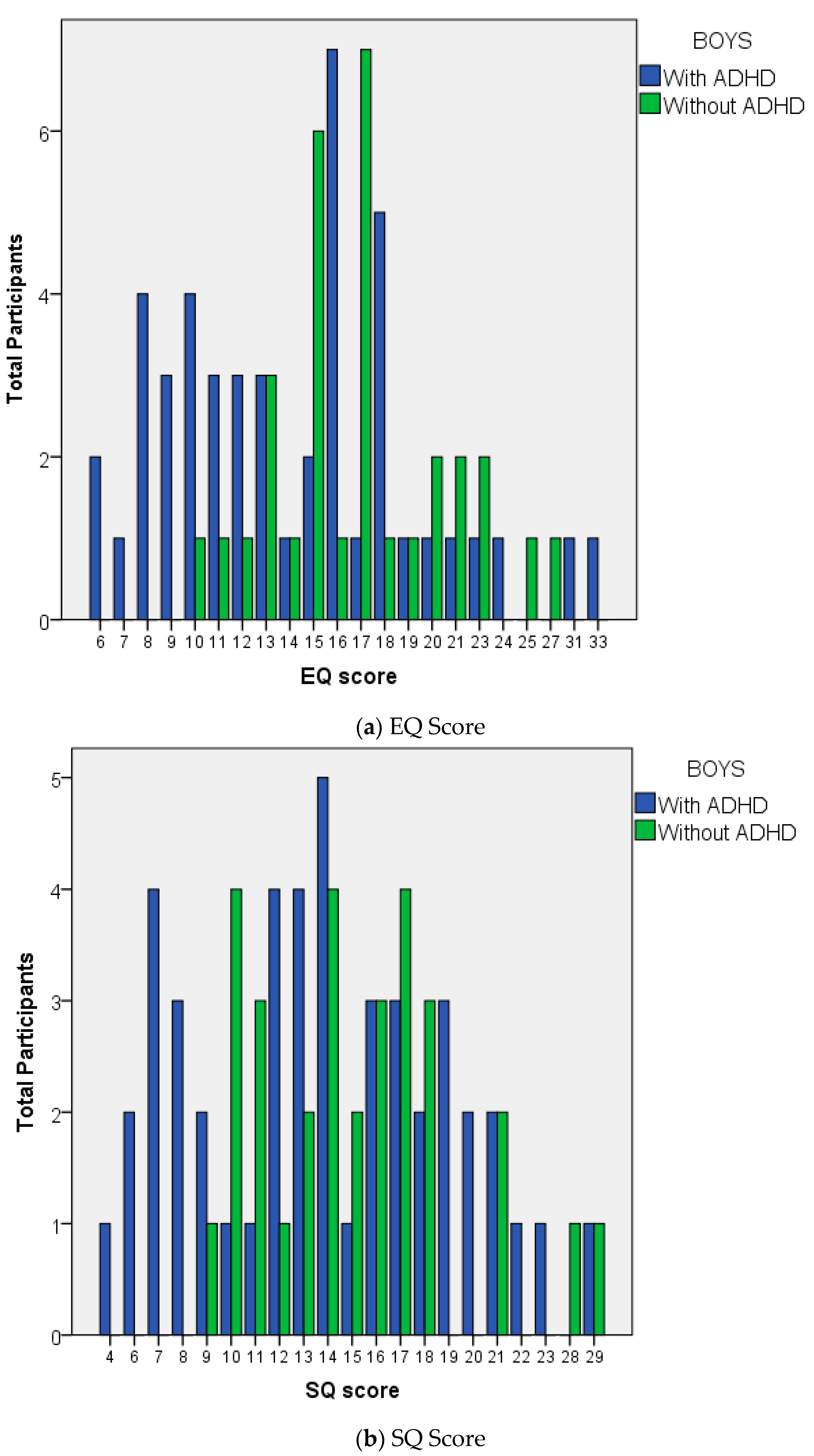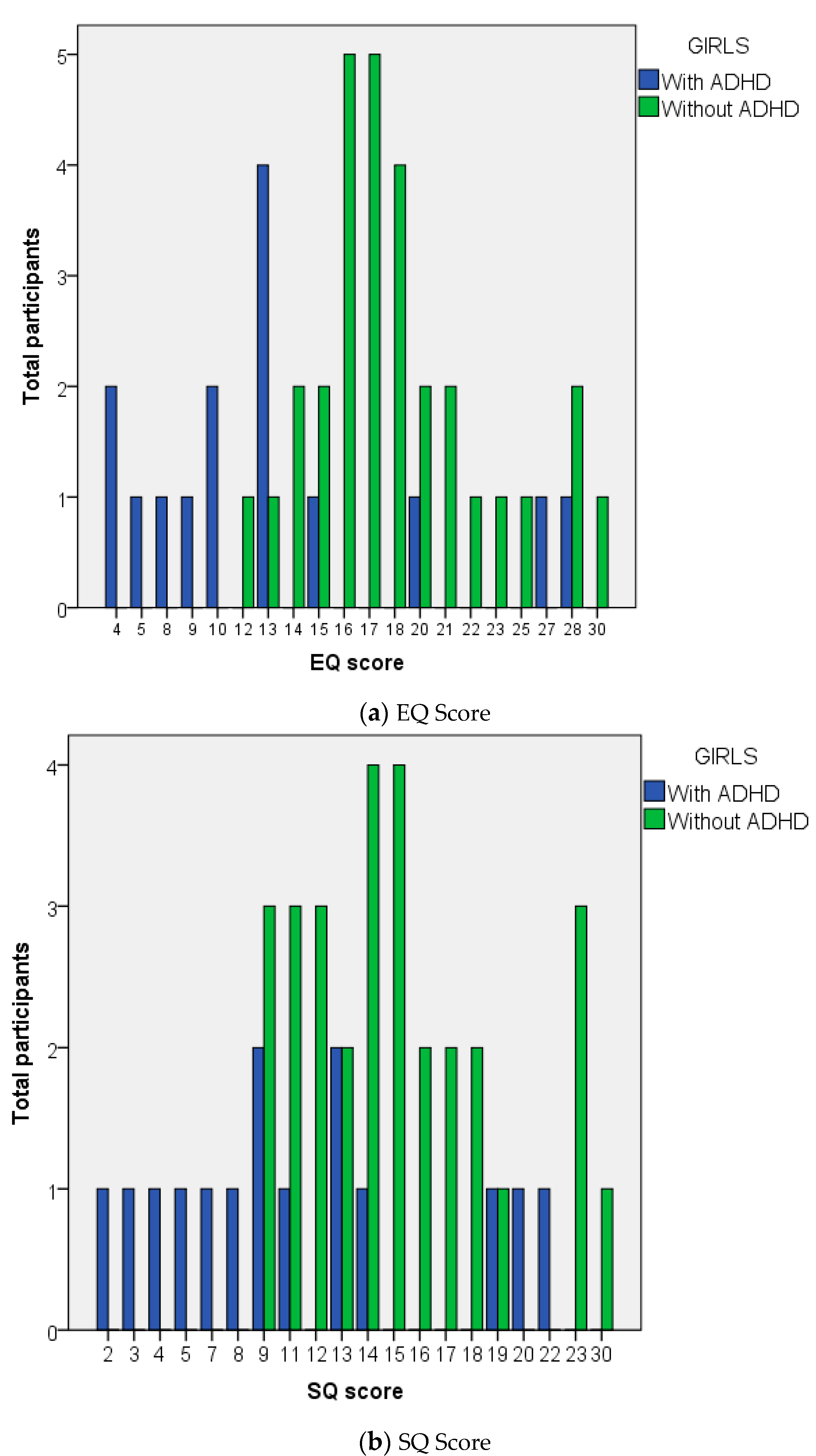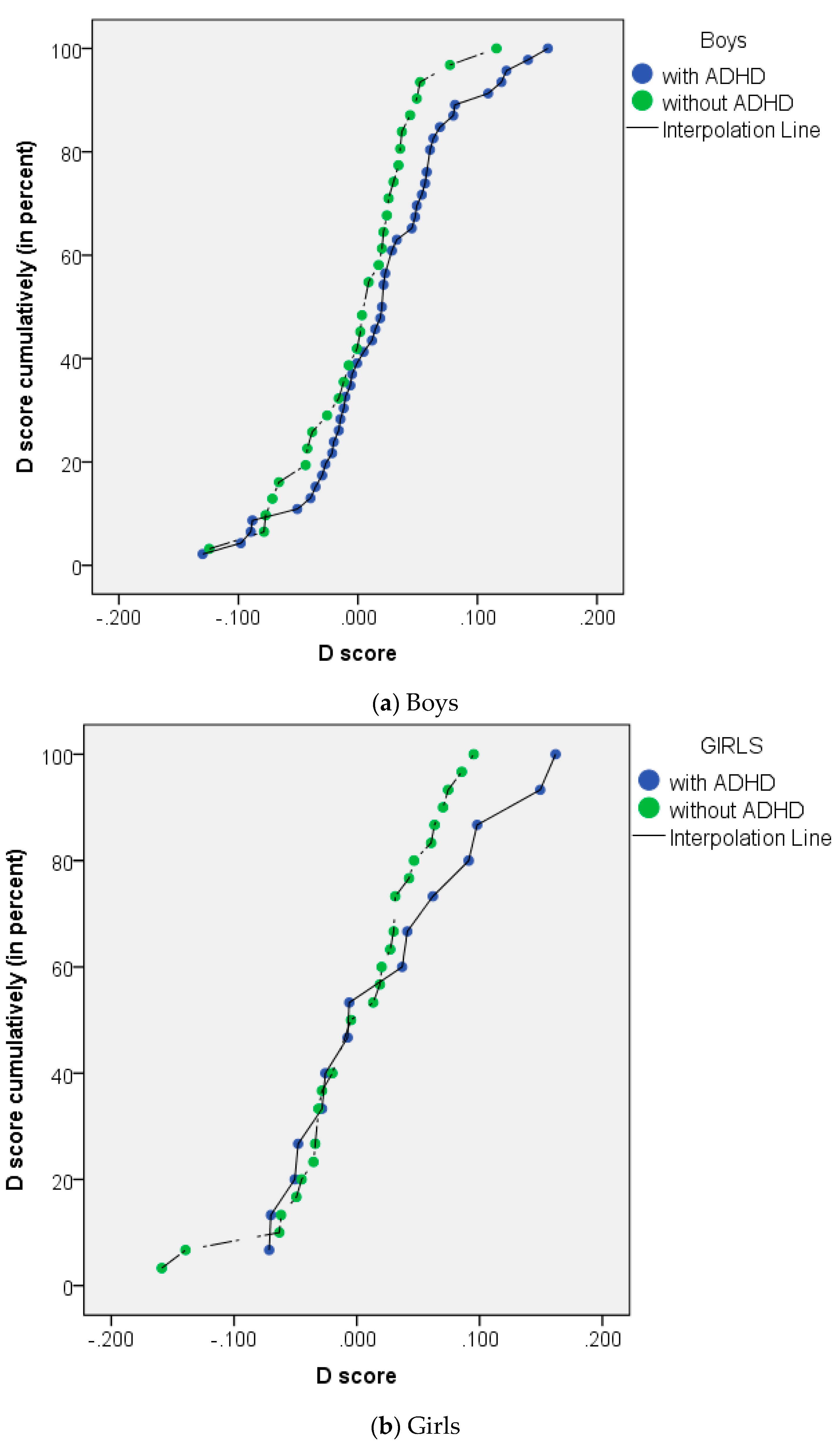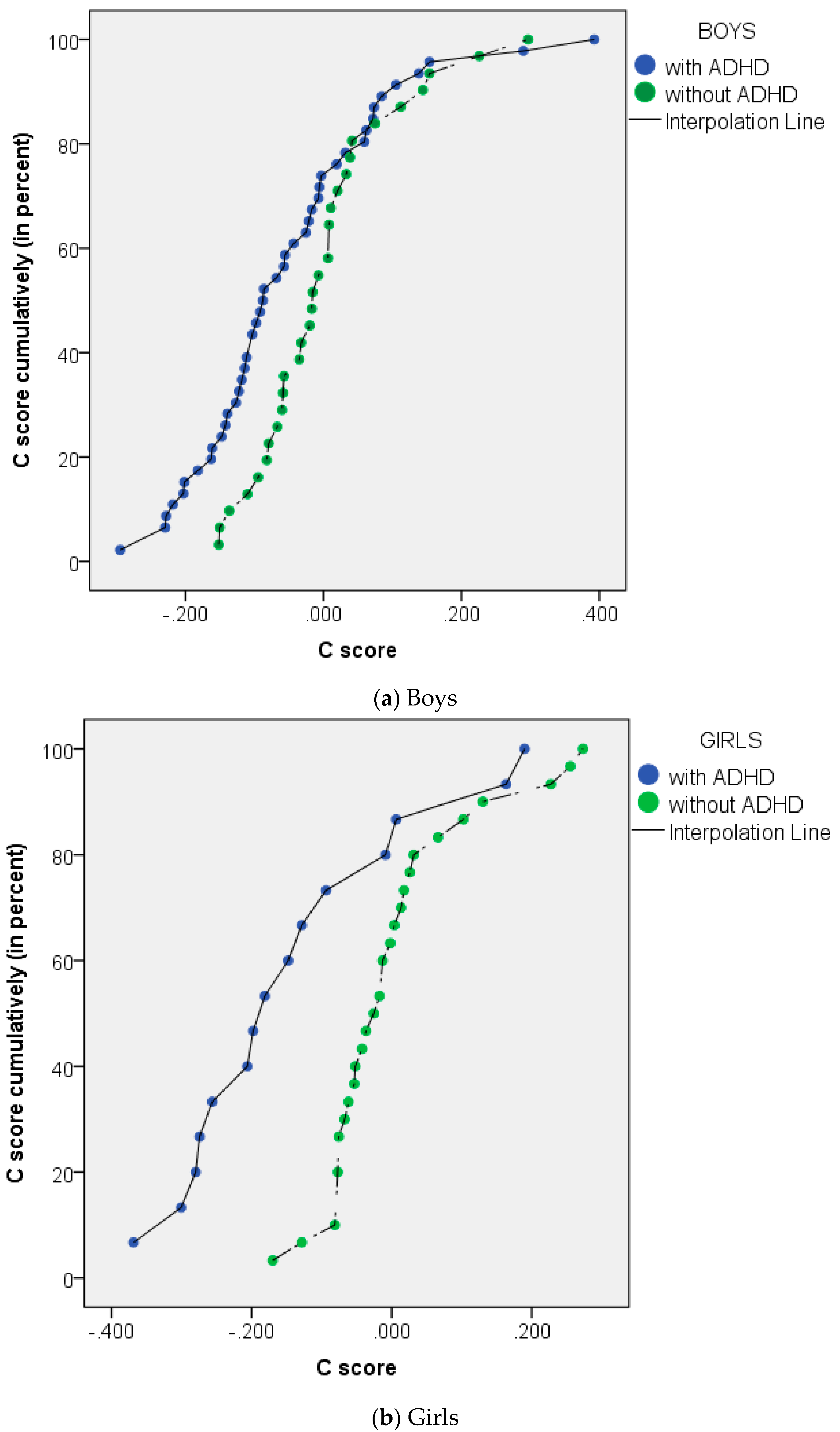Empathy Quotient and Systemizing Quotient in Elementary School Children with and without Attention-Deficit/Hyperactivity Disorder: A Comparative Study
Abstract
:1. Introduction
2. Materials and Methods
2.1. Participants
2.2. Instruments
2.3. Data Analysis
3. Results
4. Discussions
5. Conclusions
Author Contributions
Funding
Institutional Review Board Statement
Informed Consent Statement
Data Availability Statement
Acknowledgments
Conflicts of Interest
References
- American Psychiatric Association. Diagnostic and Statistical Manual of Mental Disorders, 5th ed.; American Psychiatric Publishing: Arlington, VA, USA, 2013. [Google Scholar]
- Sadock, B.J.; Sadock, V.A.; Ruiz, P. Kaplan & Sadock’s Synopsis of Psychiatry: Behavioral Sciences/Clinical Psychiatry, 11th ed.; Pataky, C.S., Sussman, N., Eds.; Lippincott Williams & Wilkins: New York, NY, USA, 2015. [Google Scholar]
- Saputro, D. Attention Deficit/Hyperactivity Disorder, 1st ed; Sagung: Jakarta, Indonesia, 2009. [Google Scholar]
- Morrison, J.; Flegel, K. Interviewing Children and Adolescents, 2nd ed.; The Guilford Press: New York, NY, USA, 2016; p. 58. [Google Scholar]
- Maoz, H.; Gvirts, H.Z.; Sheffer, M.; Bloch, Y. Theory of Mind and Empathy in Children with ADHD. J. Atten. Disord. 2019, 23, 1331–1338. [Google Scholar] [CrossRef] [PubMed]
- Sadock, B.J.; Sadock, V.A.; Ruiz, P. Kaplan & Sadock’s Comprehensive Textbook of Psychiatry, 10th ed.; Teja, C., Ed.; Lippincott Williams & Wilkins: Philladelphia, PA, USA, 2017; pp. 2353–2359. [Google Scholar]
- Nathania, E.; Mahdiyyah, K.; Chaidir, K.R.; Phalapi, Y.R.; Wiguna, T. The Relationship between Empathy, Prosocial Behavior, Peer Relationships, and Emotional Problems in Elementary School Children in Indonesia. J. Nat. Sci. Biol. Med. 2019, 10, S118–S122. [Google Scholar]
- McDonald, N.; Messinger, D. The Development of Empathy: How, When, and Why. Miami. 2011. Available online: https://www.researchgate.net/publication/267426505_The_Development_of_Empathy_How_When_and_Why (accessed on 7 April 2019).
- Goldenfeld, N.; Baron-Cohen, S.; Wheelwright, S. Empathizing and Systemizing in Boys, Girls, and Autism. Clin. Neuropsychiatr. 2005, 2, 338–345. [Google Scholar]
- Baron-Cohen, S.; Richler, J.; Bisarya, D.; Gurunathan, N.; Wheelwright, S. The Systemizing Quotient: An Investigation of Adults with Asperger Syndrome or High-Functioning Autism, and Normal Sex Differences. Philos. Trans. R. Soc. Lond. B Biol. Sci. 2003, 358, 361–374. [Google Scholar] [CrossRef] [Green Version]
- Auyeung, B.; Wheelwright, S.; Allison, C.; Atkinson, M.; Samarawickrema, N.; Baron-Cohen, S. The Children’s Empathy Quotient and Systemizing Quotient: Sex Differences in Typical Development and in Autism Spectrum Conditions. J. Autism Dev. Disord. 2009, 39, 1509–1521. [Google Scholar] [CrossRef] [PubMed]
- Aviles, C.B.; Emick, J.; Garcia, P.; Glidewell, R.; The Systemizing Quotient in Adults with Asperger’s Syndrome, ADHD, and a Control Group. Capella University. 2014. Available online: https://www.proquest.com/docview/1500561616/71F09BD25B134E09PQ/1?accountid=17242 (accessed on 27 September 2020).
- Groen, Y.; den Heijer, A.E.; Fuermaier, A.B.M.; Althaus, M.; Tucha, O. Reduced Emotional Empathy in Adults with Subclinical ADHD: Evidence from the Empathy and Systemizing Quotient. Atten. Defic. Hyperact. Disord. 2018, 10, 141–150. [Google Scholar] [CrossRef] [PubMed]
- Sasanti, Y.; Hawari, D.; Humris, E. Penentuan Validitas dan Reliabilitas Abbreviated Conners Teacher Rating Scale (ACTRS) Sebagai Penyaring Kegiatan Hiperaktivitas: Suatu Uji Instrumen Pada Sekolah Dasar; Universitas Indonesia: Depok, Indonesia, 1998. [Google Scholar]
- Sheehan, D.V.; Sheehan, K.H.; Shytle, R.D.; Janavs, J.; Bannon, Y.; Rogers, J.E.; Milo, K.M.; Stock, S.L.; Wilkinson, B. Reliability and Validity of the Mini International Neuropsychiatric Interview for Children and Adolescents (MINI-KID). J. Clin. Psychiatry 2010, 71, 313–326. [Google Scholar] [CrossRef]
- Hartadi, S.T.; Gangguan Mental Pada Anak dan Remaja Dengan HIV dan Berbagai Faktor yang Berhubungan. Universitas Indonesia. 2015. Available online: http://lib.ui.ac.id/file?file=digital/2016-3/20405358-SP-ShielyTilieHartadi.pdf (accessed on 27 September 2020).
- Phallapi, Y.R.; Wiguna, T.; Nathania, E.; Chaidir, K.R.; Mahdiyyah, K. Validity and Reliability Study of the Indonesian Empathy Quotient-Systemizing/Quotient for Children (EQ-C/SQ-C). Int. J. Child Dev. Ment. Health 2018, 6, 56–67. [Google Scholar]
- Chaidir, K.R.; Nathania, E.; Mahdiyyah, K.; Phallapi, Y.R.; Wiguna, T. Gender Differences in Brain Type According to the Empathy/Systemizing Quotient for Children (EQ/SQ-C) Questionnaire in Indonesia. J. Child. Adolesc. Ment. Health 2020, 32, 111–117. [Google Scholar] [CrossRef]
- Auyeung, B.; Lombardo, M.V.; Baron-Cohen, S. Prenatal and Postnatal Hormone Effects on the Human Brain and Cognition. Pflugers Arch. 2013, 465, 557–571. [Google Scholar] [CrossRef]
- Chapman, E.; Baron-Cohen, S.; Auyeung, B.; Knickmeyer, R.; Taylor, K.; Hackett, G. Fetal Testosterone and Empathy: Evidence from the Empathy Quotient (EQ) and the “Reading the Mind in the Eyes” Test. Soc. Neurosci. 2006, 1, 135–148. [Google Scholar] [CrossRef] [PubMed]
- Wang, L.J.; Chou, M.C.; Chou, W.J.; Lee, M.J.; Lee, S.Y.; Lin, P.Y.; Lee, Y.H.; Yang, Y.H.; Yen, C.F. Potential Role of Pre- and Postnatal Testosterone Levels in Attention-Deficit/Hyperactivity Disorder: Is There a Sex Difference? Neuropsychiatr. Dis. Treat. 2017, 13, 1331–1339. [Google Scholar] [CrossRef] [Green Version]
- Cordier, R.; Bundy, A.; Hocking, C.; Einfeld, S. Empathy in the Play of Children with Attention Deficit Hyperactivity Disorder. OTJR Occup. Particip. Health 2010, 30, 122–132. [Google Scholar] [CrossRef]
- Parke, E.M.; Becker, M.L.; Graves, S.J.; Baily, A.R.; Paul, M.G.; Freeman, A.J.; Allen, D.N. Social Cognition in Children with ADHD. J. Atten. Disord. 2021, 25, 519–529. [Google Scholar] [CrossRef] [PubMed]
- Marton, I.; Wiener, J.; Rogers, M.; Moore, C.; Tannock, R. Empathy and Social Perspective Taking in Children with Attention-Deficit/Hyperactivity Disorder. J. Abnorm. Child Psychol. 2009, 37, 107–118. [Google Scholar] [CrossRef] [PubMed]
- Suryani, E. Gambaran Fungsi Eksekutif pada Anak Sekolah Dasar dengan Gangguan Pemusatan Perhatian/Hiperaktivitas (GPPH) di Wilayah DKI Jakarta; Universitas Indonesia: Depok, Indonesia, 2011. [Google Scholar]
- Uekermann, J.; Kraemer, M.; Abdel-Hamid, M.; Schimmelmann, B.G.; Hebebrand, J.; Daum, I.; Wiltfang, J.; Kis, B. Social Cognition in Attention-Deficit Hyperactivity Disorder (ADHD). Neurosci. Biobehav. Rev. 2010, 34, 734–743. [Google Scholar] [CrossRef]
- Linn, M.C.; Petersen, A.C. Emergence and Characterization of Sex Differences in Spatial Ability: A Meta-Analysis. Child Dev. 1985, 56, 1479–1498. [Google Scholar] [CrossRef] [PubMed]
- Mackintosh, N.J.; Bennett, E.S. What Do Raven’s Matrices Measure? An Analysis in Terms of Sex Differences. Intelligence 2005, 33, 663–674. [Google Scholar] [CrossRef]
- Ling, J.; Burton, T.C.; Salt, J.L.; Muncer, S.J. Psychometric Analysis of the Systemizing Quotient (SQ) Scale. Br. J. Psychol. 2009, 100, 539–552. [Google Scholar] [CrossRef] [PubMed]
- Deschamps, P.K.H.; Schutter, D.J.L.G.; Kenemans, J.L.; Matthys, W. Empathy and Prosocial Behavior in Response to Sadness and Distress in 6- to 7-Year Olds Diagnosed with Disruptive Behavior Disorder and Attention-Deficit Hyperactivity Disorder. Eur. Child Adolesc. Psychiatry 2015, 24, 105–113. [Google Scholar] [CrossRef]
- Wakabayashi, A.; Baron-Cohen, S.; Wheelwright, S.; Goldenfeld, N.; Delaney, J.; Fine, D.; Smith, R.; Weil, L. Development of Short Forms of the Empathy Quotient (EQ-Short) and the Systemizing Quotient (SQ-Short). Personal. Individ. Differ. 2006, 41, 929–940. [Google Scholar] [CrossRef]
- Lai, M.C.; Lombardo, M.V.; Chakrabarti, B.; Ecker, C.; Sadek, S.A.; Wheelwright, S.J.; Murphy, D.G.; Suckling, J.; Bullmore, E.T.; Consortium, M.A.; et al. Individual Differences in Brain Structure Underpin Empathizing-Systemizing Cognitive Styles in Male Adults. Neuroimage 2012, 61, 1347–1354. [Google Scholar] [CrossRef] [PubMed] [Green Version]
- Allison, C.; Baron-Cohen, S.; Stone, M.H.; Muncer, S.J. Rasch Modeling and Confirmatory Factor Analysis of the Systemizing Quotient-Revised (SQ-R) Scale. Span. J. Psychol. 2015, 18, E16. [Google Scholar] [CrossRef] [PubMed] [Green Version]




| Variable | With ADHD Group (n = 61) | Without ADHD Group (n = 61) | p-Value | ||
|---|---|---|---|---|---|
| Frequency | % | Frequency | % | ||
| Boys | |||||
| Father’s Education Level | |||||
| Elementary school | 3 | 6.5 | 0 | 0.0 | |
| Junior high school | 4 | 8.7 | 1 | 3.2 | |
| Senior high school | 19 | 41.3 | 24 | 77.4 | 0.231 |
| Associate Degree | 6 | 13.0 | 2 | 6.5 | |
| Bachelor or more | 12 | 26.1 | 4 | 12.9 | |
| No Answer | 2 | 4.3 | 0 | 0.0 | |
| Mother’s Education Level | |||||
| Elementary school | 2 | 4.3 | 0 | 0.0 | |
| Junior high school | 5 | 10.9 | 3 | 9.7 | |
| Senior high school | 20 | 43.5 | 18 | 58.1 | |
| Associate Degree | 5 | 10.9 | 5 | 16.1 | 0.843 |
| Bachelor or more | 13 | 28.3 | 5 | 16.1 | |
| No answer | 1 | 2.2 | 0 | 0.0 | |
| Socio-economic status | |||||
| Low | 12 | 26.1 | 7 | 22.6 | |
| Middle-low | 24 | 52.2 | 16 | 51.6 | |
| Middle-High | 10 | 21.7 | 6 | 19.4 | 1.000 |
| High | 0 | 0.0 | 2 | 6.5 | |
| Girls | |||||
| Father’s Education Level | |||||
| Elementary school | 1 | 6.7 | 0 | 0.0 | |
| Junior high school | 0 | 0.0 | 1 | 3.3 | |
| Senior high school | 8 | 53.3 | 18 | 60.0 | |
| Associate Degree | 2 | 13.3 | 2 | 6.7 | |
| Bachelor or more | 4 | 26.7 | 9 | 30.0 | 1.000 |
| Mother’s Education Level | |||||
| Elementary school | 2 | 13.3 | 0 | 0.0 | |
| Junior high school | 2 | 13.3 | 3 | 10.0 | |
| Senior high school | 6 | 40.0 | 17 | 56.7 | |
| Associate Degree | 2 | 13.3 | 3 | 10.0 | 0.944 |
| Bachelor or more | 3 | 20.0 | 7 | 23.3 | |
| Socio-economic status | |||||
| Low | 5 | 33.3 | 3 | 10.0 | |
| Middle-low | 5 | 33.3 | 19 | 63.3 | |
| Middle-High | 4 | 26.7 | 7 | 23.3 | 0.648 |
| High | 1 | 6.7 | 1 | 3.3 | |
| Variable | With ADHD Group (n = 61) | Without ADHD Group (n = 61) | p-Value | ||
|---|---|---|---|---|---|
| Frequency | % | Frequency | % | ||
| Boys | |||||
| Children’ age | |||||
| 7 years old | 2 | 4.3 | 6 | 19.4 | |
| 8 years old | 10 | 21.7 | 3 | 9.7 | |
| 9 years old | 7 | 15.2 | 5 | 16.1 | 0.408 |
| 10 years old | 13 | 28.3 | 10 | 32.3 | |
| 11 years old | 7 | 15.2 | 3 | 9.7 | |
| ≥12 years old | 7 | 15.2 | 4 | 12.9 | |
| Grade | |||||
| Grade 1–3 | 28 | 60.9 | 15 | 48.4 | 0.279 |
| Grade 4–6 | 18 | 39.1 | 16 | 51.7 | |
| Girls | |||||
| Children’ age | |||||
| 7 years old | 1 | 6.7 | 9 | 30.0 | |
| 8 years old | 2 | 13.3 | 4 | 13.3 | |
| 9 years old | 7 | 46.7 | 5 | 16.7 | 0.263 |
| 10 years old | 1 | 6.7 | 8 | 26.7 | |
| 11 years old | 1 | 6.7 | 1 | 3.3 | |
| ≥12 years old | 3 | 20.0 | 3 | 10.0 | |
| Grade | |||||
| Grade 1–3 | 9 | 60% | 15 | 50% | 0.526 |
| Grade 4–6 | 6 | 40% | 15 | 50% | |
| With ADHD Group | Without ADHD Group | Effect Size/ p-Value | |
|---|---|---|---|
| Boys | |||
| EQ | |||
| Mean (SD) | 14.35 (5.88) | 17.03 (4.01) | −0.67/0.010 * |
| Median | 13.5 | 17 | |
| Range | 6–33 | 10–27 | |
| SQ | |||
| Mean (SD) | 13.91 (5.4) | 15.32 (4.78) | −0.29/0.288 ** |
| Median | 14 | 15 | |
| Range | 4–29 | 9–29 | |
| Girls | |||
| EQ | |||
| Mean (SD) | 12.8 (7.36) | 18.6 (4.49) | −1.29/0.002 ** |
| Median | 13 | 17 | |
| Range | 4–28 | 12–30 | |
| SQ | |||
| Mean (SD) | 10.6 (6.23) | 15.27 (4.75) | −0.98/0.008 ** |
| Median | 9 | 14.5 | |
| Range | 2–22 | 9–33 | |
| Brain Type | |||||
|---|---|---|---|---|---|
| Extreme Empathy | Empathy | Balance | Systemizing | Extreme Systemizing | |
| Percentile D < 2.5 | 2.5 ≤ Percentile < 35 | 35 ≤ Percentile < 65 | 65 ≤ Percentile < 97.5 | Percentile ≥ 97.5 | |
| D< −0.16 | −0.16 ≤ D < −0.016 | −0.016 ≤ D < 0.029 | 0.029 ≤ D < 0.105 | D ≥ 0.105 | |
| Children with ADHD (n = 61) | 0 | 17 | 13 | 24 | 7 |
| Children without ADHD (n = 61) | 1 | 23 | 16 | 20 | 1 |
Publisher’s Note: MDPI stays neutral with regard to jurisdictional claims in published maps and institutional affiliations. |
© 2021 by the authors. Licensee MDPI, Basel, Switzerland. This article is an open access article distributed under the terms and conditions of the Creative Commons Attribution (CC BY) license (https://creativecommons.org/licenses/by/4.0/).
Share and Cite
Lasmono, A.; Ismail, R.I.; Kaligis, F.; Minayati, K.; Wiguna, T. Empathy Quotient and Systemizing Quotient in Elementary School Children with and without Attention-Deficit/Hyperactivity Disorder: A Comparative Study. Int. J. Environ. Res. Public Health 2021, 18, 9231. https://doi.org/10.3390/ijerph18179231
Lasmono A, Ismail RI, Kaligis F, Minayati K, Wiguna T. Empathy Quotient and Systemizing Quotient in Elementary School Children with and without Attention-Deficit/Hyperactivity Disorder: A Comparative Study. International Journal of Environmental Research and Public Health. 2021; 18(17):9231. https://doi.org/10.3390/ijerph18179231
Chicago/Turabian StyleLasmono, Agnes, Raden Irawati Ismail, Fransiska Kaligis, Kusuma Minayati, and Tjhin Wiguna. 2021. "Empathy Quotient and Systemizing Quotient in Elementary School Children with and without Attention-Deficit/Hyperactivity Disorder: A Comparative Study" International Journal of Environmental Research and Public Health 18, no. 17: 9231. https://doi.org/10.3390/ijerph18179231
APA StyleLasmono, A., Ismail, R. I., Kaligis, F., Minayati, K., & Wiguna, T. (2021). Empathy Quotient and Systemizing Quotient in Elementary School Children with and without Attention-Deficit/Hyperactivity Disorder: A Comparative Study. International Journal of Environmental Research and Public Health, 18(17), 9231. https://doi.org/10.3390/ijerph18179231






